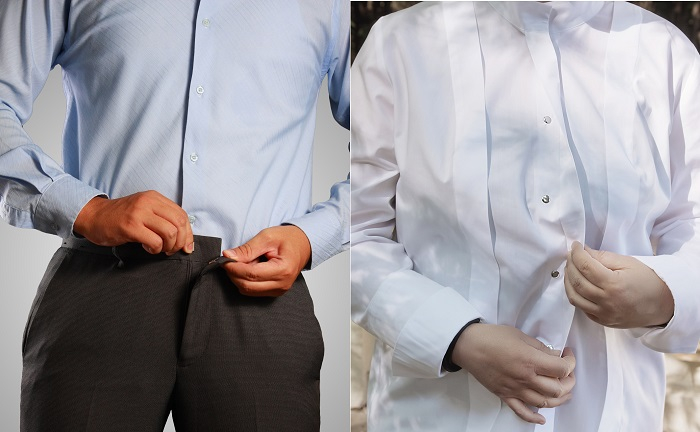

The placket, one of the most crucial elements of a dress shirt, keeps your shirt looking sharp and performing effectively. For the modern man, there are four basic types of plackets, each of which performs a particular function in the construction of a shirt: buttoning without a front placket, buttoning with a placket, hidden buttons, and a popover. Each of these laces helps the dress shirt fit various usage scenarios. Plackets are completed openings designed to make donning and removing clothing simple. Plackets are held closed (for a proper fit) when the garment is in use with the help of closures like zips, buttons and buttonholes, push buttons, hooks and eyes, etc. They are used at the waist, neck, wrist, and other areas of clothing that are too small.

The French term “plaquer,” which means to lay on, is the source of the English word “pocket.” It is the flap of fabric that covers an aperture or slit in a garment that allows access to a pocket or covers fastenings. Simply put, a placket is the strip that extends from the end of the collar to the end of the shirt and through which you button your shirt. A placket, which is a crucial component of practically every garment (for men, women, and children), is often sewn into the front centre of a man’s shirt at the time of construction.
Major types are
The seam or the slash can be used to create these packets. It is typically used in children’s clothing, sari petticoats, and sleeve openings for a cuff or band. Bulky materials or curved seams are not recommended for use with these packets.
Zipper plackets are typically available in a variety of sizes. It makes donning the garment simpler. In terms of appearance, zippers also add style to the garment. The wearer will find it challenging to operate the zipper if the pull tab disengages from the teeth or rail, so the zipper must be carefully opened and closed. This can be incorporated into a skirt, dress, blouse, handbag, pair of jeans, stylish purse, and other clothing items.
This straightforward neck finish is utilised on new-borns, kids’ clothing, and nightgowns. To create this, cut the neck opening at the centre of the front or back and cover it with fitted facing. Sew a row closer to the fabric, catching it with the right sides of the facing the garment. Top stitch after rotating the facing to the incorrect side. Hemming and twisting the edge complete the facing.
The fitted placket, which goes by the same name, is typically used to strengthen and enhance the clothing. These packets are specifically used in children’s clothing as well as men’s clothing, such as shirts, sleeve openings, and neck openings. The strips used for women’s and children’s clothing might occasionally be in contrast colours or materials to add additional decorative effect. On lightweight fabric shirts and tailored suit blouses, the tailored or “mitre” placket is especially elegant. The gauntlet, a broad band of overlap that bespoke shirt manufacturers refer to as the finishing touch, and a narrow binding on the underlap complete the opening.
Two-piece plackets are typically seen in the left seam of skirts and petticoats as well as the back seat of dresses. On the placket’s underlap side, finish by binding and overlapping with a face, pressing the facing inward while ironing the seam allowance in the direction of the facing. Once more, fold the facing over the stitches and press. Topstitch down the inside border of the facing to secure it to the other side while keeping the right side of your sleeve facing up. Fold the placket with the right sides of the cloth facing each other by turning your sleeve inside out. Stitch diagonally across the top of the binding (at the “v”), creating a small triangle.
Plackets can also be made on a seam to strengthen it and improve the appearance.
The best plackets are modest and as flat as they can be. It must not be very large or stretched. No gaps should be visible between the edges, and the fastening should hold it firmly.
When selecting a certain placket for a specific garment, careful consideration must be given to the type of garment and its placement depending on the wearer’s age and sex, the type of cloth, etc.
The opening of the plackets should be strengthened with extra care since it may get stretched during repeated wearing or removal (particularly at the closed ends, lower end of neck and skirt openings, upper end of wrist openings, etc.).
Placket openings must be positioned correctly to ensure that they are both easily accessible and practical to use.
A placket is an excellent way to personalise your shirt exactly how you want it. A terrific method to customise your made-to-measure shirt exactly how you want it to be, taking into account where you will be wearing it, is by adding a suitable placket. It is advised to wear a shirt with a no-placket (French placket) with or without a tie for a modern man who wears suits to the office and attends more formal events and meetings.
It is advised to choose a regular placket for men who enjoy dressing in shirt and tie combinations or a sophisticated casual style. This placket pairs well with blazers, stylish pants, suits, and jeans. There is no hard and fast rule when it comes to no placket or standard placket, but the only rule to follow is the one for the concealed placket. When purchasing a tuxedo or groom suit, always choose the concealed placket for the shirt to achieve the sophisticated black tie look.